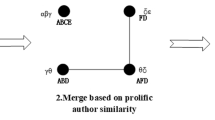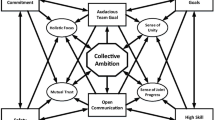Abstract
Free/Libre Open Source Software (FLOSS) development teams provide an interesting and convenient setting for studying distributed work. We begin by answering perhaps the most basic question: what is the social structure of these teams? We conducted social network analyses of bug-fixing interactions from three repositories: Sourceforge, GNU Savannah and Apache Bugzilla. We find that some OSS teams are highly centralized, but contrary to expectation, others are not. Projects are mostly quite hierarchical on four measures of hierarchy, consistent with past research but contrary to the naive image of these projects. Furthermore, we find that the level of centralization is negatively correlated with project size, suggesting that larger projects become more modular, or possibly that becoming more modular is a key to growth. The paper makes a further methodological contribution by identifying appropriate analysis approaches for interaction data. We conclude by sketching directions for future research.
Similar content being viewed by others
References
Alho, K., & Sulonen, R. (1998). Supporting virtual software projects on the web. Paper presented at the Workshop on Coordinating Distributed Software Development Projects, 7th International Workshop on Enabling Technologies: Infrastructure for Collaborative Enterprises (WETICE’98).
Armstrong, D. J., & Cole, P. (2002). Managing distance and differences in geographically distributed work groups. In P. Hinds & S. Kiesler (Eds.), Distributed work (pp. 167–186). Cambridge, MA: MIT Press.
Bergquist, M., & Ljungberg, J. (2001). The power of gifts: Organizing social relationships in open source communities. Information Systems Journal, 11(4), 305–320.
Carmel, E., & Agarwal, R. (2001). Tactical approaches for alleviating distance in global software development. IEEE Software (March/April), 22–29.
Cox, A. (1998). Cathedrals, bazaars and the town council. Retrieved 22 March 2004, from 〈http://slashdot.org/features/98/10/13/1423253.shtml〉.
Crowston, K. (1997). A coordination theory approach to organizational process design. Organization Science, 8(2), 157–175.
Crowston, K., Howison, J., & Annabi, H. (in press). Information systems success in Free and Open Source Software development: Theory and measures. Software Process—Improvement and Practice.
Curtis, B., Krasner, H., & Iscoe, N. (1988). A field study of the software design process for large systems. CACM, 31(11), 1268–1287.
Cutosksy, M. R., Tenenbaum, J. M., & Glicksman, J. (1996). Madefast: Collaborative engineering over the internet. Communications of the ACM, 39(9), 78–87.
Gacek, C., & Arief, B. (2004). The many meanings of open source. IEEE Software, 21(1), 34–40.
Ghosh, R. A. (2002). Free/libre and open source software: Survey and study. Report of the floss workshop on advancing the research agenda on free/open source software. From 〈http://www.infonomics.nl/FLOSS/report/workshopreport.htm〉.
Grinter, R. E., Herbsleb, J. D., & Perry, D. E. (1999). The geography of coordination: Dealing with distance in R&D work. In Proceedings of the group ’99 conference (pp. 306–315). Phoenix, Arizona, US.
Herbsleb, J. D., & Grinter, R. E. (1999). Architectures, coordination, and distance: Conway’s law and beyond. IEEE Software (September/October), 63–70.
Hertel, G., Niedner, S., & Herrmann, S. (2003). Motivation of software developers in open source projects: An internet-based survey of contributors to the Linux kernel. Research Policy, 32(7), 1159–1177.
Kamada, T., & Kawai, S. (1989). An algorithm for drawing general unidirected graphs. Information Processing Letters, 31, 7–15.
Krackhart, D. (1993). Graph theoretical dimensions of informal organizations. In K. M. Carley & M. J. Prietula (Eds.), Computational organization theory (pp. 89–111). Hillsdale, NJ: Lawrence Erlbaum.
Krishnamurthy, S. (2002). Cave or community? An empirical examination of 100 mature open source projects. First Monday, 7(6).
Kuwabara, K. (2000). Linux: A bazaar at the edge of chaos. First Monday, 5(3).
Mockus, A., Fielding, R. T., & Herbsleb, J. D. (2000). A case study of open source software development: The Apache server. Paper presented at the Proceedings of the International Conference on Software Engineering (ICSE’2000).
Mockus, A., Fielding, R. T., & Herbsleb, J. D. (2002). Two case studies of open source software development: Apache and Mozilla. ACM Transactions on Software Engineering and Methodology, 11(3), 309–346.
Moon, J. Y., & Sproull, L. (2000). Essence of distributed work: The case of Linux kernel. First Monday, 5(11).
Nejmeh, B. A. (1994). Internet: A strategic tool for the software enterprise. Communications of the ACM, 37(11), 23–27.
Raymond, E. S. (1998a). The cathedral and the bazaar. First Monday, 3(3).
Raymond, E. S. (1998b). Homesteading the noosphere. First Monday 3(10).
Scacchi, W. (1991). The software infrastructure for a distributed software factory. Software Engineering Journal, 6(5), 355–369.
Wasserman, S., & Frost, K. (1994). Social network analysis: Methods and applications. New York: Cambridge.
Ye, Y., & Kishida, K. (2003). Toward an understanding of the motivation of open source software developers. In Proceedings of 2003 international conference on software engineering (ICSE2003). Portland, OR.
Author information
Authors and Affiliations
Additional information
He is currently program director for the school’s Ph.D. in Information Science and Technology. Prior to moving to Syracuse, he taught for five years at the University of Michigan Business School. He received his A.B. in Applied Mathematics (Computer Science) from Harvard University and a Ph.D. in Information Technologies from the Sloan School of Management, MIT. His current research interests focus on new ways of organizing made possible by the use of information technology.
His research interests is in technology and collaboration and currently focuses on the social science of software engineering and “wireless grids” (distributed ad hoc resource sharing). He received his undergraduate degree in economics and politics from the University of Sydney. In 2001 he undertook graduate study in Software Engineering at the University of New South Wales before transferring to the Syracuse University School of Information Studies Ph.D. program in 2002. He was recently published in IEEE Internet Computing and First Monday. He is a sometime contributor to “Bibdesk,” an open source bibliographic manager for OS X.
Rights and permissions
About this article
Cite this article
Crowston, K., Howison, J. Hierarchy and centralization in free and open source software team communications. Know Techn Pol 18, 65–85 (2006). https://doi.org/10.1007/s12130-006-1004-8
Issue Date:
DOI: https://doi.org/10.1007/s12130-006-1004-8




